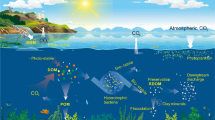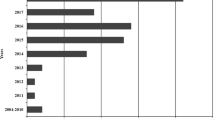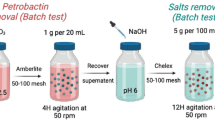Abstract
Radiocarbon (14C) measurement of dissolved organic carbon (DOC) is a very powerful tool to study the sources, transformation and cycling of carbon in the ocean. The technique, however, remains great challenges for complete and successful oxidation of sufficient DOC with low blanks for high precision carbon isotopic ratio analysis, largely due to the overwhelming proportion of salts and low DOC concentrations in the ocean. In this paper, we report an effective UV-Oxidation method for oxidizing DOC in natural waters for radiocarbon analysis by accelerator mass spectrometry (AMS). The UV-oxidation system and method show 95%±4% oxidation efficiency and high reproducibility for DOC in both river and seawater samples. The blanks associated with the method was also low (about 3 µg C) that is critical for 14C analysis. As a great advantage of the method, multiple water samples can be oxidized at the same time so it reduces the sample processing time substantially compared with other UV-oxidation method currently being used in other laboratories. We have used the system and method for 14C studies of DOC in rivers, estuaries, and oceanic environments and have received promise results.
Similar content being viewed by others
References
Bauer, J. E., Cai, W. J., Raymond, P. A., Bianchi, T. S., Hopkinson, C. S., and Regnier, P. A., 2013. The changing carbon cycle of the coastal ocean. Nature, 504: 61–70.
Bauer, J. E., Williams, P. M., and Druffel, E. R. M., 1992. 14C activity of dissolved Organic carbon fractions in the N. central Pacific and Sargasso Sea. Nature, 357: 667–670.
Beaupre, S. R., Druffel, E. R. M., and Griffin, S., 2007. A lowblank phytochemical extraction system for concentration and isotopic analyses of marine dissolved organic carbon. Limnology and Oceanography: Methods, 5: 174–184.
Becker, J. W., Berube, P. M., Follett, C. L., Waterbury, J. B., Chrisholm, S. W., DeLong E. F., and Repeta, D. J., 2014. Closely related phytoplankton species produce similar suites of dissolved organic matter. Frontiers in Microbiology, DOI: 10.3389/fmicb.2014.00111.
Druffel, E. R. M., and Bauer, J. E., 2000. Radio carbon distributions in Southern Ocean dissolved and particulate organic matter. Geophysical Research Letters, 27: 1495–1498.
Druffel, E. R. M., Williams, P. M., Bauer, J. E., and Ertel, J. R., 1992. Cycling of dissolved and particulate organic matter in the open ocean. Journal Geophysical Research, 97: 15639–15659.
Follett, C. L., Repeta, D. J., Rothman, D. H., Xu, L., and Santinelli, C., 2014. Hidden cycle of dissolved organic carbon in the deep ocean. PNAS, 111: 16706–16711.
Hansell, A. A., Carlson, C. A., Repeta, D., and Schlitzer, R., 2009. Dissolved organic matter in the ocean: New insights stimulated by a controversy. Oceanography Magazine, 22: 202–211.
Hansell, D. A., and Carlson, C. A., 2001. Biogeochemistry of total organic carbon and nitrogen in the Sargasso Sea: Control by convective overturn. Deep Sea Research Part II: Topical Studies in Oceanography, 48: 1649–1667, DOI: 10.1016/S0967-0645(00)00153-3.
Hansell, D. A., and Carlson, C. A., 2002. Biogeochemistry of Marine Dissolved Organic Matter. Academic Press, Beijing, 774pp.
Hedges, J. I., 1992. Global biogeochemical cycles: Progress and problems. Marine Chemistry, 39: 67–93.
Jiao, N. Z., and Azam, F., 2011. Microbial carbon pump and its significance for carbon sequestration in the ocean. In: Microbial Carbon Pump in the Ocean. Jiao, N., et al., eds., Science/AAAs, Washington D. C., 43–45, DOI: 10.1126/science.opms.sd 0001.
Jiao, N. Z., Herndl, G. J., Hansell, D. A., Benner, R., Kattner, G., Wilhelm, S. W., Kirchman, D. L., Weinbauer, M. G., Luo, T. W., Chen, F., and Azam, F., 2010. Microbial production of recalcitrant dissolved organic matter: Long-term carbon storage in the global ocean. Nature Review Microbiology, 8: 593–599.
Middelbore, M., and Lundsgaard, C., 2003. Microbial activity in the Greeland Sea: Role of DOC lability, mineral nutrients and temperature. Aquatic Microbial Ecology, 32: 151–163.
Nelson, C. E., and Carlson, C. A., 2012. Tracking differential incorporation of dissolved organic carbon types among diverse lineages of Sargasso Sea bacterioplankton. Environmental Microbiology, DOI: 101111/j.1462-2920.2012.02738.x.
Raymond, P. A., and Bauer, J. E., 2001. Use of 14C and 13C natural abundances for evaluating riverine, estuarine, and coastal DOC and POC sources and cycling: A review and synthesis. Organic Geochemistry, 32: 469–485, DOI: 10.1016/S0146-6380(00) 00190-X.
Sharp, J. H., Benner, R., Bennett, L., Carlson, C. A., Dow, R., and Fitzwater, S. E., 1993. Re-evaluation of high-temperature combustion and chemical oxidation measurements of dissolved organic in seawater. Limnology and Oceanography, 38: 1774–1782.
Wang, X. C., and Ge, T. T., Xue, Y. J., and Luo, C. L., 2015. Carbon isotopic (14C and 13C) characterization of fossil–fuel derived dissolved organic carbon in wet precipitation in Shandong Province, China. Journal of Atmospheric Chemistry, DOI: 10.1007/s10874-015-9323-3.
Wang, X. C., Ma, H. Q., Li, R. H., Song, Z. S., and Wu, J. P., 2012. Seasonal fluxes and source variation of organic carbon transported by two major Chinese rivers: The Yellow River and Changjiang (Yangtze) River. Global Biogeochemical Cycle, 26, DOI: 10.1029/2011GB004130.
Williams, P. M., and Druffel, E. R. M., 1987. Radiocarbon in dissolved organic carbon in the central North Pacific Ocean. Nature, 330: 246–248.
Williams, P. M., Robertson, K. J., Soutar, A., Griffin, S. M., and Druffel, E. R. M., 1992. Isotopic signatures (14C, 13C, 15N) as tracers of sources and cycling of soluble and particulate organic matter in the Santa Monica Basin, California. Progress in Oceanography, 30: 253–290, DOI: 10.1016/0079-6611(92)90015-R.
Author information
Authors and Affiliations
Corresponding author
Rights and permissions
About this article
Cite this article
Xue, Y., Ge, T. & Wang, X. An effective method of UV-oxidation of dissolved organic carbon in natural waters for radiocarbon analysis by accelerator mass spectrometry. J. Ocean Univ. China 14, 989–993 (2015). https://doi.org/10.1007/s11802-015-2935-z
Received:
Revised:
Accepted:
Published:
Issue Date:
DOI: https://doi.org/10.1007/s11802-015-2935-z




